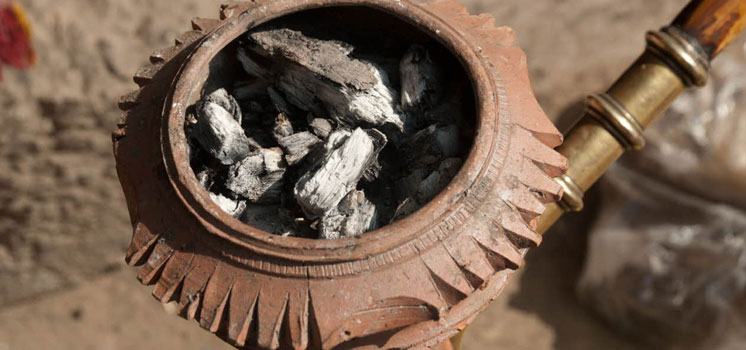Waterpipe tobacco
In many parts of the world people use a waterpipe to smoke tobacco. This is particularly true in the Eastern Mediterranean Region, where waterpipes are known variously as shisha, goza, narghile, ghalyoon or hookah.
A waterpipe works by placing a tobacco product in a small bowl with holes in the bottom which is attached to a tube linked to a water container. When the tobacco product is heated by hot charcoal placed on the tobacco it emits smoke that the user inhales by puffing on a hose connected to the water container. This draws it through the water and into their lungs.
Health risks of waterpipe tobacco use
Waterpipe tobacco use is damaging to health in similar ways to cigarette tobacco use. However, the health dangers of waterpipe tobacco use are often little understood by users. For instance, it is often wrongly believed that the smoke is purified by passing through the water in a waterpipe. Waterpipe tobacco use is not a safe alternative to cigarettes, and there is no proof that any device or accessory can make waterpipe smoking safer.
Using a waterpipe to smoke tobacco may seriously damage the health of smokers and the health of those exposed to the second-hand smoke emitted. It is important to remember that:
Waterpipe tobacco has significantly higher nicotine content than cigarettes. One head of unflavoured tobacco has the nicotine equivalent of 70 cigarettes.
Waterpipe tobacco also contains numerous toxins known to cause lung disease, cancer, heart diseases and other illnesses. Even after it has been passed through water, the smoke produced by a waterpipe contains high levels of toxins, including carbon monoxide, metals and cancer-causing chemicals. A typical 1-hour long waterpipe smoking session involves inhaling 100–200 times the volume of smoke inhaled with a single cigarette.
The fuels used to heat waterpipes, including wood cinders and charcoal, produce toxins that contain high levels of carbon monoxide, metals and cancer-causing chemicals. Second-hand smoke from waterpipes is a mixture of tobacco smoke and smoke from the fuel, and therefore poses a serious risk for those inhaling it, especially children. Waterpipe use or exposure to second-hand smoke from a waterpipe can also have adverse effects during pregnancy.
Waterpipe use is linked to chronic bronchitis and respiratory disease. It also facilitates the transmission of hepatitis and herpes viruses, as well as being implicated in the transmission of an estimated 17% of cases of tuberculosis in the Region.
Increasing use of waterpipe tobacco
Waterpipe tobacco is highly addictive and its use in the Region is increasing rapidly, especially among young people and women. The Region has some of the highest rates in the world with overall rates of use of tobacco products other than cigarettes (including waterpipe tobacco) of 14% among boys age 13–15 (compared to 7% cigarette use) and 9% among girls age 13–15 (compared to 2% cigarette use). These rates are even higher in some countries of the Region. In many countries, more women and young people use other tobacco products than smoke cigarettes.
Underlying this increase is the misperception that use of tobacco products such as waterpipe tobacco is less harmful to health than smoking cigarettes. Waterpipe tobacco is not a safe alternative to cigarettes. However, the health dangers of waterpipe tobacco use are little understood by users.
Marketing waterpipe tobacco
Waterpipe smoking is becoming part of a new lifestyle trend in many countries, as a popular way to spend time with friends socializing. It is being promoted as fashionable and sophisticated. It is sometimes also portrayed as a traditional activity, appealing to people’s sense of identity and heritage. Waterpipe tobacco is available in sweetened flavours such as apple, strawberry, grape, cherry, mint and cappuccino that may particularly appeal to young people and women.
Waterpipe tobacco has not had the same amount of regulation as cigarettes. In most countries, the tobacco mixtures sold for waterpipe tobacco use do not carry health warnings on their packaging. This reinforces the perception that waterpipe tobacco use is relatively safe compared to smoking cigarettes. Some waterpipe tobacco mixtures state that they contain no tar, which is technically accurate but misleading because tar is produced during the combustion of the tobacco.
Best practices and the way forward
Waterpipe tobacco should be subjected to the same regulation as cigarettes and other tobacco products. This includes application of Article 9 of the WHO Framework Convention on Tobacco Control on the regulation of the contents and emissions of tobacco products, Article 10 on the regulation of tobacco product disclosures and Article 11 on packaging and labelling of tobacco products.
Waterpipe tobacco use should be included in tobacco control efforts. This includes:
prohibition of misleading labelling and claims of reduced harm and safety
having health warnings on waterpipe tobacco packaging
waterpipe tobacco use being prohibited in public places consistent with bans on cigarette use
education of the public and health professionals about the health risks of waterpipe tobacco use, including exposure to second-hand smoke
cessation interventions for waterpipe tobacco users.





